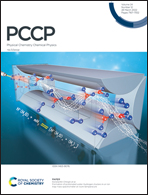Ultrafast exciton delocalization and localization dynamics of a perylene bisimide quadruple π-stack: a nonadiabatic dynamics simulation†
Abstract
Unraveling the photogenerated exciton dynamics of π-stacked molecular aggregates is of great importance for both fundamental studies and industrial applications. Among various π-stacked molecular aggregates, perylene tetracarboxylic acid bisimide (PBI) based aggregates are regarded as one of the prototypes due to their inherent high fluorescence quantum yield and excellent photostability and flexibility in controlling intermolecular forces via chemical modifications. However, the exciton dynamics of these PBI based aggregates remain elusive up to now. In this work, we have first employed LR-TDDFT-based nonadiabatic dynamics simulations and static electronic structure calculations to investigate the ultrafast exciton dynamics of a newly synthesized perylene bisimide quadruple (PBQ) π-stack. Upon photoexcitation, the S6 to S10 states are the most likely populated excited states, which can be regarded as a combination of local excited (LE) excitons and charge transfer (CT) excitons of those four PBI chromophores. Then, the excited PBQ π-stack relaxes ultrafast to the lowest lying excited S1 state within 500 fs, which is accompanied by the complicated exciton conversion as well as exciton localization/delocalization dynamics. In short, the initially populated hybrid LE and CT excitons convert to the LE excitons of B/C and A/D, in which the LE excitons of B/C contribute the most (∼0.44) while the LE excitons of A/D also have minor contributions (0.21), indicating the formation of the localized excimer state. We use the notations A/B/C/D here to represent the four PBI fragments of PBQ π-stacks along the direction perpendicular to the PBI molecular plane. Additionally, using a recently defined root mean square deviation (RMSD) of electron and hole spatial distributions along three Cartesian coordinates, we could investigate the exciton localization/delocalization dynamics in a quantitative way. Our simulation results indicate that the photoinduced electrons and holes of the PBQ π-stack exhibit an ultrafast localization(∼10 fs)-delocalization(∼60 fs)-localization(∼200 fs) dynamics, during which both LE and CT excitons play crucial roles. Our present work is not only consistent with previous experimental studies, but also provides more detailed insights into the relevant processes, which might be useful for the future design of PBI based optoelectronic devices with improved performances.



 Please wait while we load your content...
Please wait while we load your content...